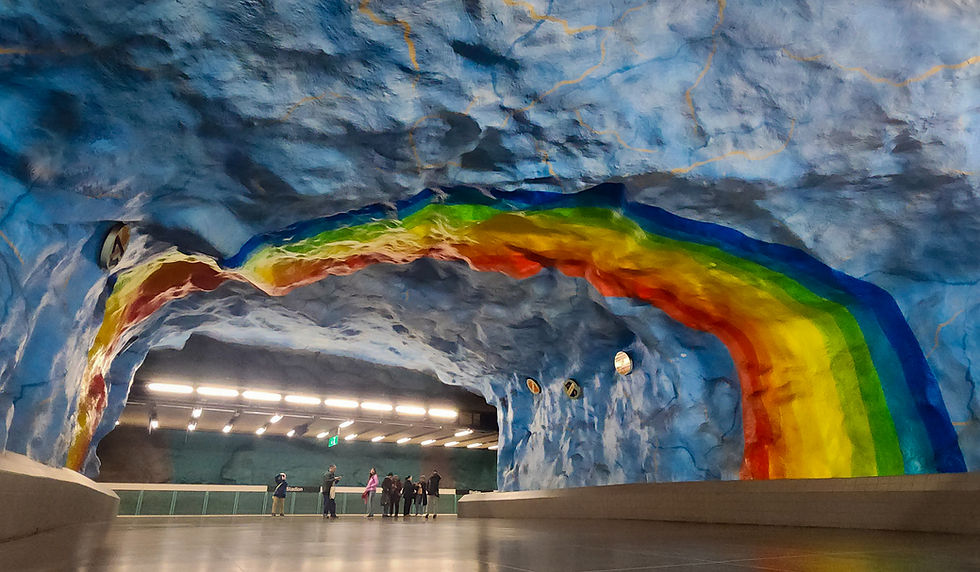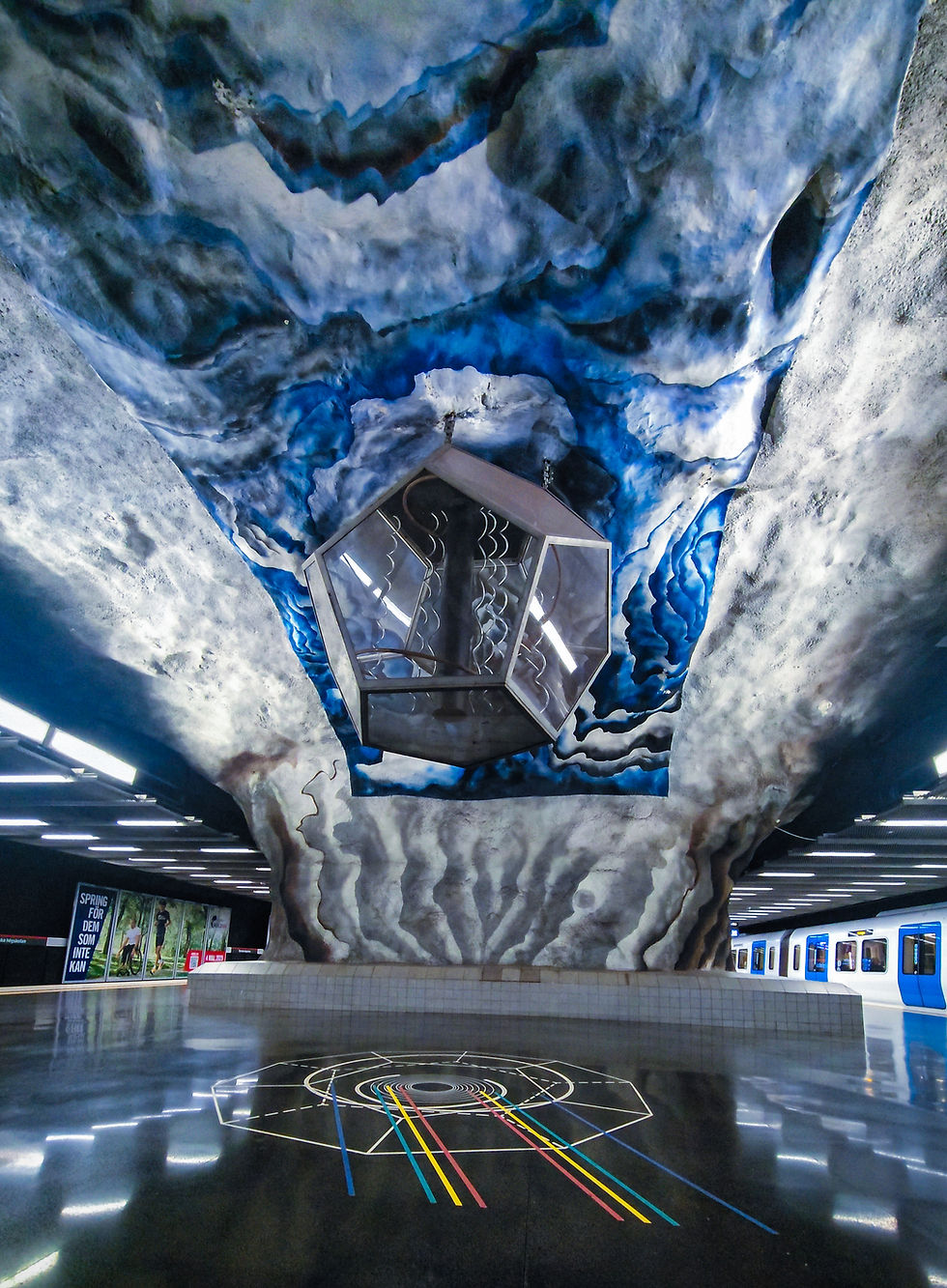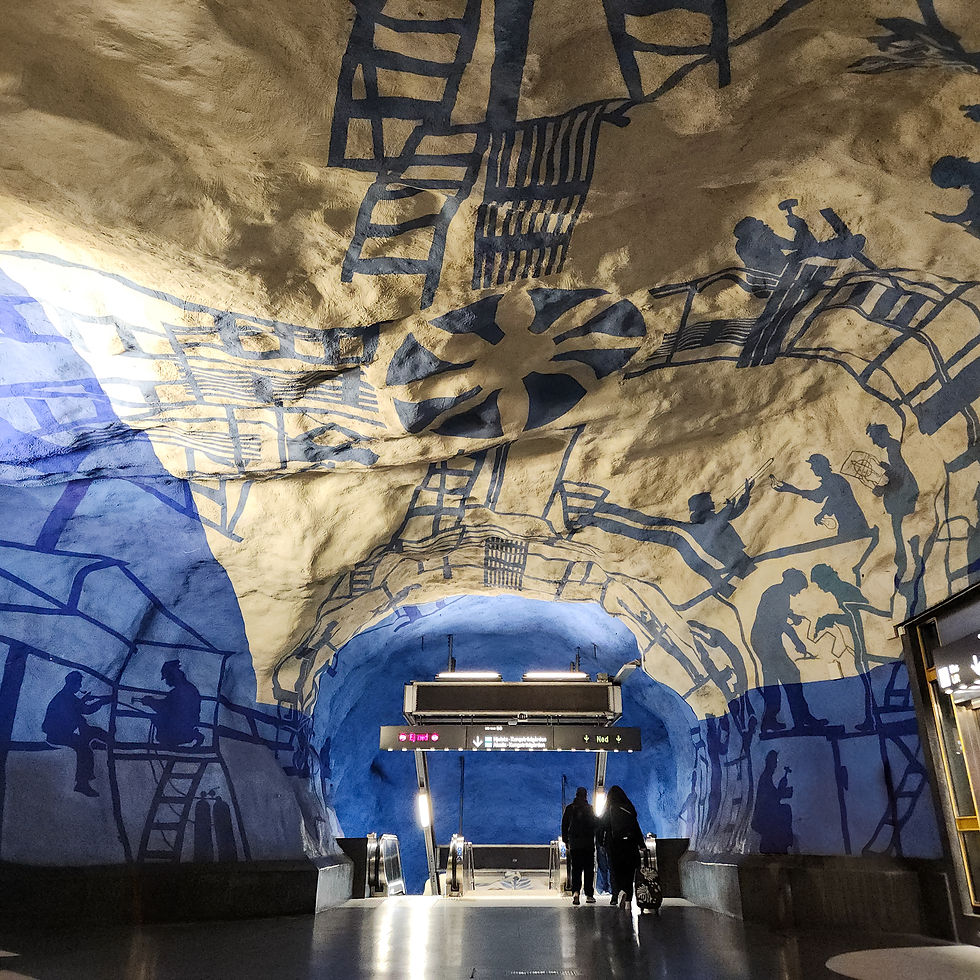Stockholm's Subway Art - A (Very) Brief Guide
- lotzacurls
- Jul 14
- 7 min read

Coming from a small mountain town in Canada, I get very excited whenever I get to use a metro system in Europe. Really excited.
When visiting Stockholm this spring, I bought a three-day metro pass and really exploited it. This wasn’t just to save time or energy, but also to visit some of Stockholm’s best-placed art pieces.
You see, in Sweden, public art is considered an important part of a democratic society; it is believed that everyone, regardless of social standing or wealth, should be able to enjoy it.
With that mindset, Stockholm artists have been ‘glowing up’ their subway stations for the past 50 years, resulting in a panoply of underground art galleries spread all over this beautiful capital. Stockholm has exactly 100 metro stations, and 90 of them have been colorfully refurbished.
I decided to spend one of my mornings riding from one esthetically-pleasing spot to the next. Turns out it’s a super cool way to discover a new city.
Logistics
Stockholm’s subway system has three main lines: red, green and blue.

A single-use ticket with sl.se is valid for 75 minutes and costs 43 krona (~6 $ CAD), but that won’t give you sufficient time to see half these stations. You could always skip a few that are farther away (Rissne and Tensta, on the #10 blue line), but I would suggest getting a day pass for 180 krona (~25 $ CAD) or a 3-day pass for 360 krona (~50 $ CAD). The fine for riding without a valid ticket is an eye-watering 1850 krona (~625 $ CAD).
Once you’re done visiting the stations, take advantage of that day pass to visit some far-away spots that can’t be reached on foot from your accommodations. I was in Stockholm for a short 3 days and since it’s a rather spread-out city, the metro system saved me a lot of time, though I still did a ton of walking.
Head there midday on Monday to Friday to avoid rush-hour crowds. I rode around on Easter Sunday and still managed to nab some shots with very few people in them. You might have to wait a bit for crowds to disperse; you most certainly won’t be the only one with a camera in hand.
Once you’ve arrived at a station, walk around a bit as the art is mostly spread out. You might have enough time to see everything and catch your next train right away. I usually let one or two trains go by before I was ready to move on. Be patient, young Jedi.
It took me about 3 hours to visit the stations on this list. Here were my 13 favourites among those I visited.
To begin, make your way to T-Centralen and head to the RED LINE, # 14 towards MÖRBY CENTRUM.. Be careful not to take #14 to FRUÄNGEN (which heads south), or #13 to ROPSTEN (which shares the track). We’ll be visiting 3 stations on this red line.
1. Stadion (1st stop on the red line)

Let’s start things off with a bang. You cannot miss this one! Creds go to artists Åke Pallarp and Enno Hallek for this very popular station art. It’s a testament to the fact that things just don’t have to be complicated.

This was one of the very first stations that needed to be carved deep out of the bedrock, and it was completed in 1973. However, its construction was rather controversial: citizens were concerned that underground stations would conjure dark and nefarious thoughts in commuters’ minds (ah, good ol’ religious superstition). So, a giant rainbow and blue skies were painted to counteract that fear (and to commemorate the 1912 Summer Olympics, which had taken place in the nearby stadium). Incidentally, and most suitably, Stockholm Pride usually kicks off near this station every year.
2. Tekniska Högskolan (2nd stop on red line)

Near this station sits the Royal Institute of Technology, so the art here is witness to many facets of physics and science. Artist Lennart Mörk has showcased Plato’s five elements (earth, fire, water, air and ether), as well as forces like gravity. It’s a testament to the wonders of our Universe.
There’s an ode to Newton (look for the apple hanging from the ceiling) and to Leonardo Da Vinci’s design of a flying contraption (with a bird’s wing, again… hanging from the ceiling). If you’re at all interested in science, this station will keep you busy.
3. Universitetet (3rd stop on red line)


Above this station lie the grounds of Stockholm University. Just like our previous stop, the art here will reflect subjects of a more academic nature.
This is a tribute to Swedish biologist and physician Carl Linnaeus, whose life was astonishingly successful (as Bill Bryson explains so delightfully in A Short History of Nearly Everything, which is an absolute must-read). Carl Linnaeus basically (well, painstakingly) came up with the entire system of classifying all plants or animals into the categories and subcategories that biologists still use today.
Artist Françoise Schein really had her work cut out for her, as this is an astonishingly well-detailed station. Again, if you’re into the natural sciences, be prepared to spend lots of time exploring.
Ok, now head South (back to T-Centralen) on
Once at T-Centralen, find the GREEN LINE to HÄSSELBY STRAND.
4. Hötorget (First stop on green line)
This is one of the oldest stations in Stockholm, built in 1952. Amazing. It has retained its original turquoise tiles and the original signage has been preserved to keep that stylish 1950s decor. Artist Gun Gordillo added the cool neon ceiling lights in 1998 and voilà! This was one of my faves, on account of its grooviness.

5. Odenplan (2nd stop on green line)

This is a massive station with three floors that go deep underground. I had to walk around quite a bit until I found the art here, and it was worth every second of my search. (It’s in the western entrance hallway, where the escalators are). Again, it’s a bit of a ways down but don’t give up on this one!
Entitled Life Line, artist David Svensson was inspired by his son’s heartbeat shown on the monitor during his birth. Dad of the Year Award.
6. Thorildsplan (3rd stop on green line)

Any gamers out there ? This is your stop!
Like most stations in Stockholm, ceramic tiles are used to decorate. But here, artist Lars Arrhenius used them to pixelate his art, so it feels like you’re caught in a giant video game.


Head back the opposite way on the green line (#18 toward FARSTA STRAND) until you get to Fridhemsplan Station. Here, you’ll switch to the BLUE LINE.
Take BLUE LINE #10 toward HJULSTA. You’ll get off at Solna Strand.
7. Solna Strand (1st stop on #10 blue line)

Not gonna lie, I took this blue line by accident (I was supposed to take #11 to AKALLA, but accidentally got onto #10 to HJULSTA instead) and just decided to go with it, as I had read about two stations on this line.
To be honest, this station felt kinda bland, although the photo turned out OK. Japanese artist Takashi Naraha explores yin and yang here, as demonstrated by the dark cave being pierced by cubes of blue sky on the platform, in the ceiling and on the walls. It does add a nice contrast, but I think more blue cubes are needed to complete the desired effect. I’m still glad I rolled into this station by accident, though.
8. Rissne (2nd stop on #10 blue line)

This is a historical world map station. There’s a huge, long timeline on one side outlining different changes to different countries throughout the ages. On the other side is a massively long list of all significant world events with a few skulls placed at particularly perilous eras (such as the Black Plague in Europe, shown above).
9. Tensta (3rd stop on #10 blue line)

Built in 1975 to accommodate an urgent need for housing for arriving immigrants, this station features art by Helga Henschen and siblings Arne and Lars Sedell, commemorating the new residents. It all took over a year to paint, and is filled with drawings of animals and plants from around the world. It is clearly a celebration of all different cultures living in the city.

Keep an eye out for the walruses and penguins perched on the wall.

Go back via blue line #10 towards Kungsträdgården and get off at Västra Skogen.
Here, you’ll be able to transfer to Blue line # 11 toward AKALLA.
Get off at Solna Centrum.
10. Solna Centrum (1st stop on blue line #11)

Artists Karl-Olov Björk and Anders Åberg have painted a whole bunch of everyday portraits onto a huge splash of green trees and red sunset. The everyday portraits address important political issues such as deforestation, environmental pollution and the depopulation of rural areas (overpopulation of cities).

11. Hallonbergen (2nd stop on blue line #11)

This one appealed to the teacher in me. Artists Elis Eriksson and Gösta Wallmark were inspired by their children’s drawings for this station. It was cute and whimsical.
12. Kungsträdgården (3rd stop on blue line #11)

This station made it onto my list because it seems so incredibly popular on the net but frankly, I just didn’t get it. It boasts a red, green and white color scheme with moss growing on the walls, and has a historical museum feel to it, since a few sculptures salvaged from demolished buildings have been added. Hence the King’s Garden above us.
13. T-Centralen (4th stop on blue line #11)

Artist Per Olof Ultvedt painted Stockholm’s central station - on the blue line - with a beautiful smattering of blue shades. His giant leaf pattern motif is calming, and his silhouetted homage to all workers who built the station is fantastic.


And there we have it!
I really found that this ride throughout Stockholm felt like an extended art museum visit. Thanks to the 150+ artists who have embellished it since the 1950s, this massive exhibition will still be there -one day- should you decide to pop into (or beneath) Sweden’s beautiful capital city. And I suggest that you do!




Comments